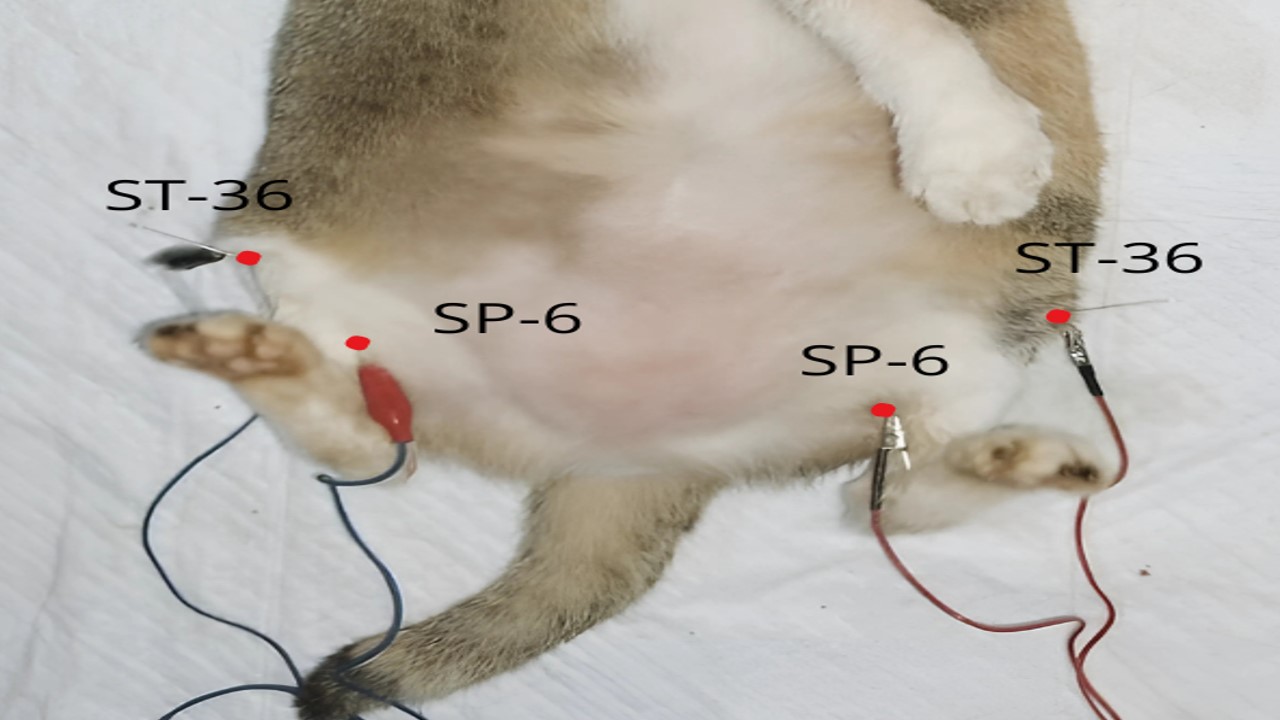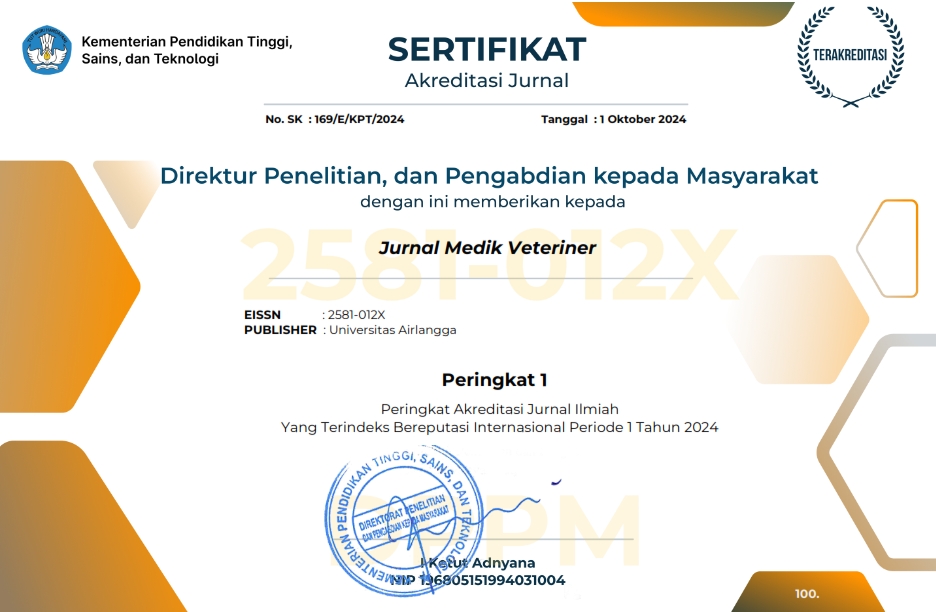Modulatory Effect of Electroacupuncture on Isoflurane Anaesthesia in Cats

Downloads
This study aimed to evaluate the combination of electroacupuncture (EA) and isoflurane as an anesthetic regimen in domestic cats. A total of 15 cats were divided into two groups, namely tiletamine-zolazepam (TZ) (n = 5) and EA (n = 10). Atropine was used as a premedication, injected 5 min before the induction of TZ. Approximately 10 min after induction, endotracheal intubation was applied, and cats were connected to isoflurane anesthesia. EA was applied to the EA group during the first 10 min of the total 30 min under isoflurane maintenance. Furthermore, the acupuncture points ST-36 and SP-6 were used at a frequency of 80 Hz and an intensity of 4 mA. The quality of anesthesia was evaluated by several parameters, including isoflurane requirements, anesthesia quality, cardiovascular function, and respiratory function. Data were collected every 10 min for a total of 30 min from the time of isoflurane application, followed by analysis using a t-test with Welch’s correction. The results showed that there was a significant reduction in isoflurane requirement in EA group, as indicated by the area under the curve (AUC) (p = 0.0003). Isoflurane concentration at 10 min was significantly lower in EA group (1.25 ± 0.71) than in TZ group (2.1 ± 0.22). It was also significantly lower at 20 min in EA group (1.05 ± 0.79) than in TZ group (1.8 ± 0.27). In conclusion, the addition of EA effectively reduced isoflurane requirements while maintaining a similar quality and safety of anesthesia in both groups.
Bacarin, C. C., Nicacio, G. M., Cerazo, L. M. L., Peruchi, L. G., & Cassu, R. N. (2022). Perioperative analgesic efficacy of yamamoto new scalp acupuncture for canine mastectomy combined with ovariohysterectomy: a randomized, controlled clinical Trial. Journal of Acupuncture and Meridian Studies, 15(2), 121–129.
Barter, L. S., Ilkiw, J. E., Steffey, E. P., Pypendop, B. H., & Imai, A. (2004). Animal dependence of inhaled anaesthetic requirements in cats. British Journal of Anaesthesia, 92(2), 275–277.
Beglinger, R., Heller, A., & Lakatos, L. (2010). Elektrokardiogramme, Herzschlagfrequenz und Blutdruck der Hauskatze (Felis catus). Journal of Veterinary Medicine Series A-physiology Pathology Clinical Medicine, 24(3), 252–257.
Cassu, N. R., Silva, D. A., Filho, T. G., & Stevanin, H. (2012). Electroanalgesia for the postoperative control pain in dogs. Acta Cirúrgica Brasileira, 27(1), 43–8.
Chen, S. J., Qing, Y. X., Qun, X., Feng, L. H., & Gang, C. (2022). Current research progress of isofluran in cerebral ischemia/perfusion injury. Medical Gas Research, 12(3), 73–76.
Culp, L. B., Skarda, R. T., & Muir III, W. W. (2005). Comparisons of the effects of acupuncture, electroacupuncture, and transcutaneous cranial electrical stimulation on the minimum alveolar concentration of isofluran in dogs. American Journal Veterinary Research, 66(8), 1364–70.
Dela Pena, J. B., & Cheong, J. H. (2016). The abuse liability of the NMDA receptor antagonist-benzodiazepine (tiletamine-zolazepam) combination: evidence from clinical case report and preclinical studies. Drug Testing Analysis, 8, 760–767.
Dijkstra, E., Teske, E., & Szatmari, V. (2018). Respiratory rate of clinically healthy cats measured in veterinary consultation rooms. Veterinary Journal, 234, 96–101.
Dou, B., Li, Y., Ma, J., Xu, Z., Fan, W., Tian, L., Chen, Z., Li, N., Gong, Y., Lyu, Z., Fang, Y., Liu, Y., Xu, Y., Wang, S., Chen, B., Guo, Y., Guo, Y., & Lin, X. (2021). Role of neuroimmune crosstalk in mediating the anti-inflammatory and analgesic effects of acupuncture on inflammatory pain. Frontiers in Neuroscience, 15, 695670.
Fikri, F., Purnomo, A., Maslamama, S. T., & Purnama, M. T. E. (2025). Effectiveness of acupuncture for equine laminitis: Systematic review and meta-analysis. Veterinary World, 18(1), 60–66.
Grint, N. J., Bufford, J., & Dugdale, A. H. A. (2009). Does pethidine effect the cardiovascular and sedative effect of dexmedethomidine in dogs?. Journal of Small Animal Practice, 50, 62–66.
Groppetti, D., Pecile, A. M., Sacerdote, P., Bronzo, V., & Ravasio, G. (2011). Effectiveness of electroacupuncture analgesia compared with opioid administration in a dog model: a pilot study. British Journal of Anaesthesia, 107(4), 612–18.
Hammond, S. (2023). Effects of intraoperative electro-acupuncture on healthy dog undergoing anesthesia for elective procedures: a randomized controlled, blinded clinical trial. American Journal of Traditional Chinese Veterinary Medicine, 18(1), 13–20.
Hodgson, D., Dunlop, C., Chapman, L., & Grandy, J. L. (1998). Cardiopulmonary effects of anesthesia induced and maintained with isoflurane in cats. American Journal of Veterinary Research, 59(2), 182–185.
Ingerson, D. J. (2023). Effect of electro-acupuncture on shelter cat anaesthesia recovery from ovariohysterectomy: a randomized and controlled clinical study. American Journal of Traditional Chinese Veterinary Medicine, 18(1), 20–26.
Jang, M., Park, S., Son, W. G., Jo, S. M., Hwang, H., Seo, K., & Lee, I. (2015). Effect of tiletamine-zolazepam on the intraoccular presssure of the dog. Veterinary Ophthalmology, 18, 481–484.
Jeong, M. S., & Nam, T. C. (2002). Effect of electroacupuncture on minimum alveolar concentration of isofluran in dogs. Journal Veterinary Medicine Science, 65(1), 145–147.
Khalifah, H., Soehartono, R. H., & Siswandi, R. (2024). A survey on anesthesia management practice by small animal veterinary in DKI Jakarta and West Java Province. Jurnal Kedokteran Hewan, 18(3), 76–82.
Kovalcuka, L., Mālniece, A., & Vanaga. J. (2024). Comparison of Tonovet® and Tonovet plus® tonometers for measuring intraocular pressure in dogs, cats, horses, cattle, and sheep. Veterinary World, 17(2), 384–388.
Lin, H. J., Shih, C. H., Kaphel, K., Wu, L. S., Tseng, W. Y., Chiu, J. H., Lee, T. C, & Wu, Y. L. (2010). Acupuncture effects on cardiac functions measured by cardiac Magnetic Resonance Imaging in a feline model. Evidence-Based Complementary and Alternative Medicine, 7(2), 169–176.
Lu, Z., Dong, H., Wang, Q., & Xiong, L. (2015). Perioperative acupuncture modulation: more than anaesthesia. British Journal of Anaesthesia, 115(2), 183–93.
Machado, M. L., Soares, J. H. N., Pypendop, B. H., Aguiar A. J. A., Braun, C., Motta, R. G. C., & Janre, F. C. (2022). Cardiovascular and gas exchange effects of individualized positive and expiratory pressure in cats anesthetized with isoflurane. Frontiers in Veterinary Science, 9, 865673.
Mann, F. A., Colette, M. S., Wagner-Mann, C., & Branson, K. R. (1997). Transcutaneous Oxygen and Carbon Dioxide monitoring in normal cats. Journal of Veterinary Emergency and Critical Care, 7(2), 99–109.
Nascimento, F. F., Marques, V. I., Crociolli, G. C., Nicacio, G. M., Nicacio, I. P. A. G., & Cassu, R. N. (2019). Analgesic efficacy of laser acupuncture and electroacupuncture in cats undergoing ovariohysterectomy. Journal of Veterinary Medical Science, 81(5), 764–770.
Novakopski, T. D., Vries, M., & Seymour, C. (2016). BSAVA Manual of Canine and Feline Anaesthesia and Analgesia Third Edition. Cambrian Printers, Aberystwyth, UK. pp: 41.
Rahmiati, U. D., Gunanti, G., Noviana, D., Soehartono, R. H., & Harlina, E. (2025). A comprehensive overview of fixed-volume hemorrhagie effects in New Zealand white rabbit model. Open Veterinary Journal, 15(3), 1253–1263.
Siswandi, R., Yoshida, A., Satoh, H., & Nonaka, N. (2019). X-Ray evaluation of intestinal dysmotility induced by Eimeria pragenesis infection in C57BL/6 mice. Journal of Veterinary Medical Science, 81(7), 1021–1028.
Wang, H., Xie, Y., Zhang, Q., Xu, N., Zhong, H., Dong, H., Liu, L., Jiang, T., Wang, Q., & Xiong, L. (2024). Transcutaneus electric acupoint stimulation reduces intra-operative remifentanil consumption and alleviates postoperative side-effects in patients undergoing sinusotomy: a prospective, randomized, placebo-controlled trial. British Journal of Anaesthesia, 112(6), 1075–82.
Ware, W. A. (1999.) Twenty-four-hour ambulatory electrocardiography in normal cats. Journal of Veterinary Internal Medicine, 13(3), 175–180.
Wei, Y., & Qiang, W. (2019). Perioperative acupuncture medicine a novel concept instead of acupuncture anesthesia. Chinese Medical Journal, 132(6), 707–715.
Copyright (c) 2025 Sri Wahyuni, R Harry Soehartono, Riki Siswandi

This work is licensed under a Creative Commons Attribution-NonCommercial-ShareAlike 4.0 International License.
Authors who publish in this journal agree to the following terms:
1. The journal allows the author to hold the copyright of the article without restrictions;
2. The journal allows the author(s) to retain publishing rights without restrictions;
3. The legal formal aspect of journal publication accessibility refers to Creative Commons Attribution-NonCommercial-ShareAlike 4.0 International License (CC BY-NC-SA).






11.jpg)




















